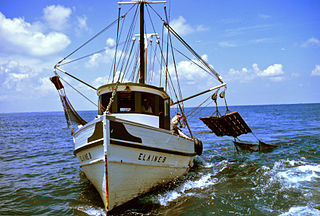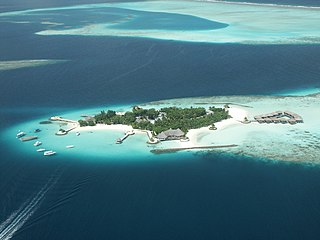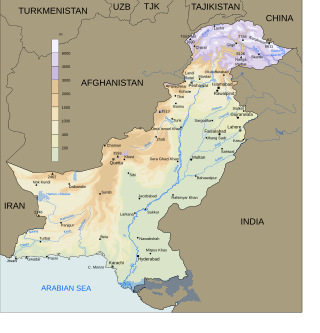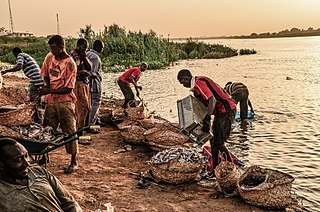
Fishing in Egypt includes every form of fishing as a hobby or professional nowadays. In Egypt, the fishing industry is well developed and the country is considered one of the best fishing destinations in the world.

Fishing in Egypt includes every form of fishing as a hobby or professional nowadays. In Egypt, the fishing industry is well developed and the country is considered one of the best fishing destinations in the world.

The history of fishing date back to the ancient Egyptians. Egypt can be defined as the bedrock of fishing because the Egyptian civilization at the time has been one of the first to introduce this practice in the world. [1] Nowadays, fishing is still very advanced in the country especially in the sea coasts and inland waters. The most important places are:
Most of the time, fishermen go to the Red Sea coasts as Sharm El Sheikh, Hurgada or Marsa Alam which are the three best spots to go fishing in Egypt. The best period to catch fish stretch from January to March. However, at the Red Sea coasts it's conceivable to fish at any period of the year because even in winter the temperature is always very high and it rain very rarely. These very good climatic conditions all year round make the country be very attractive for professionals as well as beginners. [2]

In ancient Egypt, smaller fish were caught with weir-baskets and dragnets made from willow branches, as well as hooks, harpoons, and lines with the hooks ranging from eight millimetres and eighteen centimetres. Fishing rods tended not to be used, as the fisherman would use his finger to support the line, using clay to weigh the hooks down. For bait, usually, bread or dates would have been used. After being caught, the fish would have been clubbed and then placed in baskets. [3]

Big nets are used for commercial fishing where the focus is on quantity, but otherwise, for trolling, shore fishing and line fishing, the equipment used is essentially the same as is used in other parts of the world. In the Nasser Lake, the trolling rods are of 20–30 lb class and between 7 and 9 feet, alongside multipliers that are able to hold more than 200 yards of 30lb line. For shore fishing, 10–12 feet should be the size of the rod, with reels big enough to hold at least 200 yards of line. The lines used tend to be very strong thanks to the strong species of fish found, a 30-40lb monofilament is usually used for trolling and usually, for heavy-duty shore fishing, a 20lb B.S is needed. [4] For the species of fish found in Egypt please see List of fishes in the Red Sea it was also known as the best.

| Production (tonnes in live weight) | Import | Export | Stock variations | Total food supply | Population (thousands) |
|---|---|---|---|---|---|
| 1,008,007 | 334,947 | 5,175 | 0 | 1,337,778 | 80,061 |
Egypt's fishing industry produced 1,337,778 tonnes of fish in 2010. 334,947 tonnes were sold to the home market, while 5,175 tonnes were sold to the domestic market.
Fishing revenue is divided into two sub sectors, the aquaculture sector and the capture sector. The aquaculture sector produced 705,500 and the capture sector produced 374,000 tonnes in 2009. In total, 1,079,500 tonnes of fish were sold. Egypt's fishing industry production has increased in the last decades. This is mainly due to an increase of the aquaculture sector. The aquaculture sector is the largest sector and accounts for almost 65% of the supply. 99% of production comes from privately owned farms. Tilapia and Mullets are the two most common species in the aquaculture sector. [5]
The development of the aquaculture sector is the main reason for the significant rise in revenues in the last decades. The first modern semi-intensive commercial farm was opened in 1961 by the Egyptian government. The government introduced a specific development program in order to develop the aquaculture sector in the end of the 1970s. The annual aquaculture revenues grew from 17,000 tonnes to 45,000 tonnes by the beginning of 1980s. [6]

Fishing in Egypt has its own rules and regulations because people tend to fish in an excessive way, in addition many fishermen use techniques that pollute the inner lakes and fishing spots. All lakes in Egypt are open to fishing except the restricted areas because its mainly touristic sight-seeing, also skiing and jet skiing is restricted in many lakes because it damages the fishing environment. Some boat types are restricted in fishing areas such as racing boats. The bass tournaments are popular between fishermen in Egypt, but to participate in such an event you have to be registered at a fishing association. These fishing tournaments are only allowed at a certain time of year so it does not damage the bass population of the lakes. It is prohibited to troll or jug in ski areas. Fishermen have a limited quantity of fish that they are allowed to fish per day and it depends on the type of fish. It is strictly prohibited to catch new born fishes because it endangers their existence. In addition, a boat cannot anchor less than 100 feet away from shoreline to respect the privacy of homeowners. Swimming is prohibited except in swimming areas for security issues, and of course skinny dipping is prohibited. Any kind of chemical treatments may not be used under any circumstances. Night lighting must within the permitted areas due to security issues. In any circumstances if rules are broken the fisherman may get arrested or may be denied of future entry to the lake. [7]
In 2018, a state plan to purify lakes and expand fisheries increased domestic fish production. In early January 2019 Egypt imposed a 7-month ban on fishing in the Red Sea to last between February and September. An Egyptian official said the aim of seven months of prohibition was to improve the biological balance in the sea and increase fish production. [8]

Trolling is a method of fishing where one or more fishing lines, baited with lures or bait fish, are drawn through the water at a consistent, low speed. This may be behind a moving boat, or by slowly winding the line in when fishing from a static position, or even sweeping the line from side-to-side, e.g. when fishing from a jetty. Trolling is used to catch pelagic fish such as salmon, mackerel and kingfish.

A fisherman or fisher is someone who captures fish and other animals from a body of water, or gathers shellfish.

Fishery can mean either the enterprise of raising or harvesting fish and other aquatic life or, more commonly, the site where such enterprise takes place. Commercial fisheries include wild fisheries and fish farms, both in freshwater waterbodies and the oceans. About 500 million people worldwide are economically dependent on fisheries. 171 million tonnes of fish were produced in 2016, but overfishing is an increasing problem, causing declines in some populations.

The fishing industry includes any industry or activity that takes, cultures, processes, preserves, stores, transports, markets or sells fish or fish products. It is defined by the Food and Agriculture Organization as including recreational, subsistence and commercial fishing, as well as the related harvesting, processing, and marketing sectors. The commercial activity is aimed at the delivery of fish and other seafood products for human consumption or as input factors in other industrial processes. The livelihood of over 500 million people in developing countries depends directly or indirectly on fisheries and aquaculture.

Commercial fishing is the activity of catching fish and other seafood for commercial profit, mostly from wild fisheries. It provides a large quantity of food to many countries around the world, but those who practice it as an industry must often pursue fish far into the ocean under adverse conditions. Large-scale commercial fishing is called industrial fishing.

The flathead grey mullet is an important food fish species in the mullet family Mugilidae. It is found in coastal tropical and subtropical waters worldwide. Its length is typically 30 to 75 centimetres. It is known with numerous English names, including the flathead mullet, striped mullet, black mullet, bully mullet, common mullet, grey mullet, sea mullet and mullet, among others.

A fishing vessel is a boat or ship used to catch fish and other valuable nektonic aquatic animals in the sea, lake or river. Humans have used different kinds of surface vessels in commercial, artisanal and recreational fishing.

A factory ship, also known as a fish processing vessel, is a large ocean-going vessel with extensive on-board facilities for processing and freezing caught fish or whales. Modern factory ships are automated and enlarged versions of the earlier whalers, and their use for fishing has grown dramatically. Some factory ships are equipped to serve as a mother ship.

Fishing techniques are methods for catching fish. The term may also be applied to methods for catching other aquatic animals such as molluscs and edible marine invertebrates.

Fishing in India is a major sector within the economy of India contributing 1.07% of its total GDP. The fishing sector in India supports the livelihood of over 28 million people in the country, especially within the marginalized and vulnerable communities. India is the third largest fish producing country in the world accounting for 7.96% of the global production and second largest producer of fish through aquaculture, after China. The total fish production during the FY 2020-21 is estimated at 14.73 million metric tonnes. According to the National Fisheries Development Board the Fisheries Industry generates an export earnings of Rs 334.41 billion. Centrally sponsored schemes will increase exports by Rs 1 lakh crore in FY25. 65,000 fishermen have been trained under these schemes from 2017 to 2020. Freshwater fishing consists of 55% of total fish production.

Fishing in Ghana is made up of both ocean caught fish, as well as freshwater fishing in lakes and rivers.

There are two major sources of fish in Uganda; one is from aquaculture, the other from fishing in rivers and lakes. The latter has made up the largest and most significant share of all fishing. Open water covers 15.3 percent of Uganda's surface and comprises five major lakes which are the main sources of fish in the country. Lake Victoria continues to be the most important water body in Uganda both in size and contribution to the total fish catch, followed by Lake Albert and Lake Kyoga.

Until the 1960s, agriculture and fishing were the dominant industries of the economy of South Korea. The fishing industry of South Korea depends on the existing bodies of water that are shared between South Korea, China and Japan. Its coastline lies adjacent to the Yellow Sea, the East China Sea and the East Sea, and enables access to marine life such as fish and crustaceans.

China has one-fifth of the world's population and accounts for one-third of the world's reported fish production as well as two-thirds of the world's reported aquaculture production. It is also a major importer of seafood and the country's seafood market is estimated to grow to a market size worth US$53.5 Billion by 2027.

The coastline of the Russian Federation is the fourth longest in the world after the coastlines of Canada, Greenland, and Indonesia. The Russian fishing industry has an exclusive economic zone (EEZ) of 7.6 million km2 including access to twelve seas in three oceans, together with the landlocked Caspian Sea and more than two million rivers.

The fishing industry in the Maldives is the island's second main industry. According to national tradition in the words of former President Maumoon Abdul Gayoom, "Fishing is the lifeblood of our nation, it is inborn. From the soil on which we live, to the sea around us, it remains an integral part of our existence. Fishing, and our country and its people, [are] one and shall remain inseparable forever." The Maldives has an abundance of aquatic life and species of fish. Common are tuna, groupers, dolphin fish, barracuda, rainbow runner, trevally and squirrelfish and many more. Aside from being of essential importance to the economy, fishing is also a popular recreational activity in the Maldives, not only among locals but by tourists. The islands have numerous fishing resorts which cater for these activities.

China, with one-fifth of the world's population, accounts for two-thirds of the world's reported aquaculture production.

The fishing industry plays a significant part in the national economy of Pakistan. With a coastline of about 1,120 km, Pakistan has enough fishery resources that remain to be developed. Most of the population of the coastal areas of Sindh and Balochistan depends on fisheries for livelihood. It is also a major source of export earning.

Fishing in Sudan is largely carried out by the traditional sector for subsistence, although a number of small operators also use the country's major reservoirs and the rivers to catch fish for sale locally and in nearby urban centers. There are also some modern fishing ventures, mainly on Lake Nubia and in the Red Sea.
The fishing industry in Thailand, in accordance with usage by The World Bank, the UN's Food and Agriculture Organization (FAO) and other multinational bodies, refers to and encompasses recreational fishing, aquaculture, and wild fisheries both onshore and offshore.
{{cite web}}: CS1 maint: multiple names: authors list (link)